A Detailed Analysis: The Creation and Evolution of the Internet
VerifiedAdded on 2023/06/04
|26
|6137
|442
Report
AI Summary
This report provides a comprehensive overview of the creation and evolution of the internet. It begins with the early concepts predating the first computer, discussing the efforts of scientists like Nicola Tesla and visionaries like Paul Otlet. The report then details the crucial role of ARPANET, the first prototype of the internet, developed by the US Department of Defense, and the concept of packet switching. It examines the development of TCP/IP protocol, which standardized data transmission, and the introduction of the World Wide Web, which popularized the internet. The report explores subsequent developments like Web 2.0, mobile internet connectivity, and the introduction of social networking media and Internet-of-Things. This report is a detailed exploration of the key milestones and technologies that shaped the digital landscape, from its early days to its current form.
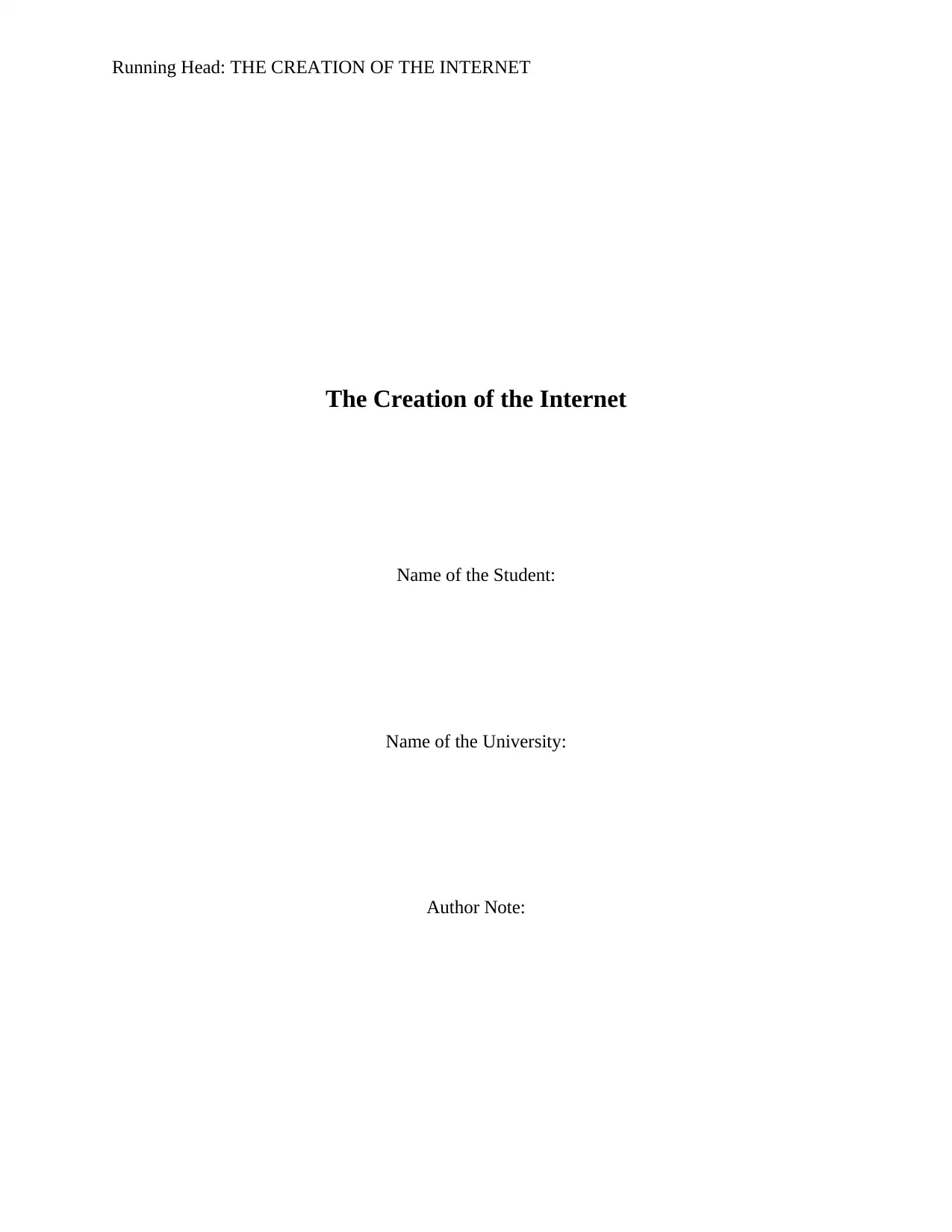
Running Head: THE CREATION OF THE INTERNET
The Creation of the Internet
Name of the Student:
Name of the University:
Author Note:
The Creation of the Internet
Name of the Student:
Name of the University:
Author Note:
Paraphrase This Document
Need a fresh take? Get an instant paraphrase of this document with our AI Paraphraser
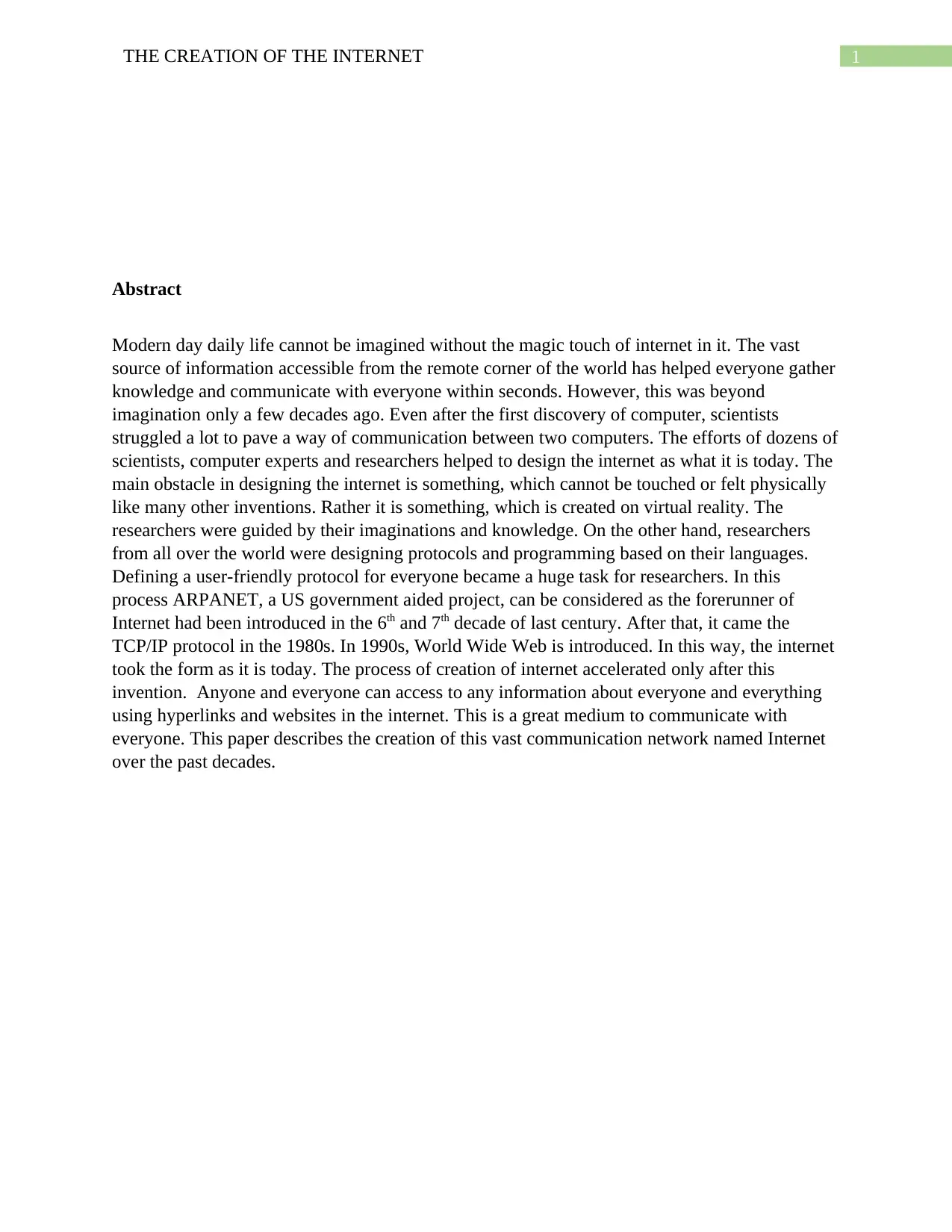
1THE CREATION OF THE INTERNET
Abstract
Modern day daily life cannot be imagined without the magic touch of internet in it. The vast
source of information accessible from the remote corner of the world has helped everyone gather
knowledge and communicate with everyone within seconds. However, this was beyond
imagination only a few decades ago. Even after the first discovery of computer, scientists
struggled a lot to pave a way of communication between two computers. The efforts of dozens of
scientists, computer experts and researchers helped to design the internet as what it is today. The
main obstacle in designing the internet is something, which cannot be touched or felt physically
like many other inventions. Rather it is something, which is created on virtual reality. The
researchers were guided by their imaginations and knowledge. On the other hand, researchers
from all over the world were designing protocols and programming based on their languages.
Defining a user-friendly protocol for everyone became a huge task for researchers. In this
process ARPANET, a US government aided project, can be considered as the forerunner of
Internet had been introduced in the 6th and 7th decade of last century. After that, it came the
TCP/IP protocol in the 1980s. In 1990s, World Wide Web is introduced. In this way, the internet
took the form as it is today. The process of creation of internet accelerated only after this
invention. Anyone and everyone can access to any information about everyone and everything
using hyperlinks and websites in the internet. This is a great medium to communicate with
everyone. This paper describes the creation of this vast communication network named Internet
over the past decades.
Abstract
Modern day daily life cannot be imagined without the magic touch of internet in it. The vast
source of information accessible from the remote corner of the world has helped everyone gather
knowledge and communicate with everyone within seconds. However, this was beyond
imagination only a few decades ago. Even after the first discovery of computer, scientists
struggled a lot to pave a way of communication between two computers. The efforts of dozens of
scientists, computer experts and researchers helped to design the internet as what it is today. The
main obstacle in designing the internet is something, which cannot be touched or felt physically
like many other inventions. Rather it is something, which is created on virtual reality. The
researchers were guided by their imaginations and knowledge. On the other hand, researchers
from all over the world were designing protocols and programming based on their languages.
Defining a user-friendly protocol for everyone became a huge task for researchers. In this
process ARPANET, a US government aided project, can be considered as the forerunner of
Internet had been introduced in the 6th and 7th decade of last century. After that, it came the
TCP/IP protocol in the 1980s. In 1990s, World Wide Web is introduced. In this way, the internet
took the form as it is today. The process of creation of internet accelerated only after this
invention. Anyone and everyone can access to any information about everyone and everything
using hyperlinks and websites in the internet. This is a great medium to communicate with
everyone. This paper describes the creation of this vast communication network named Internet
over the past decades.
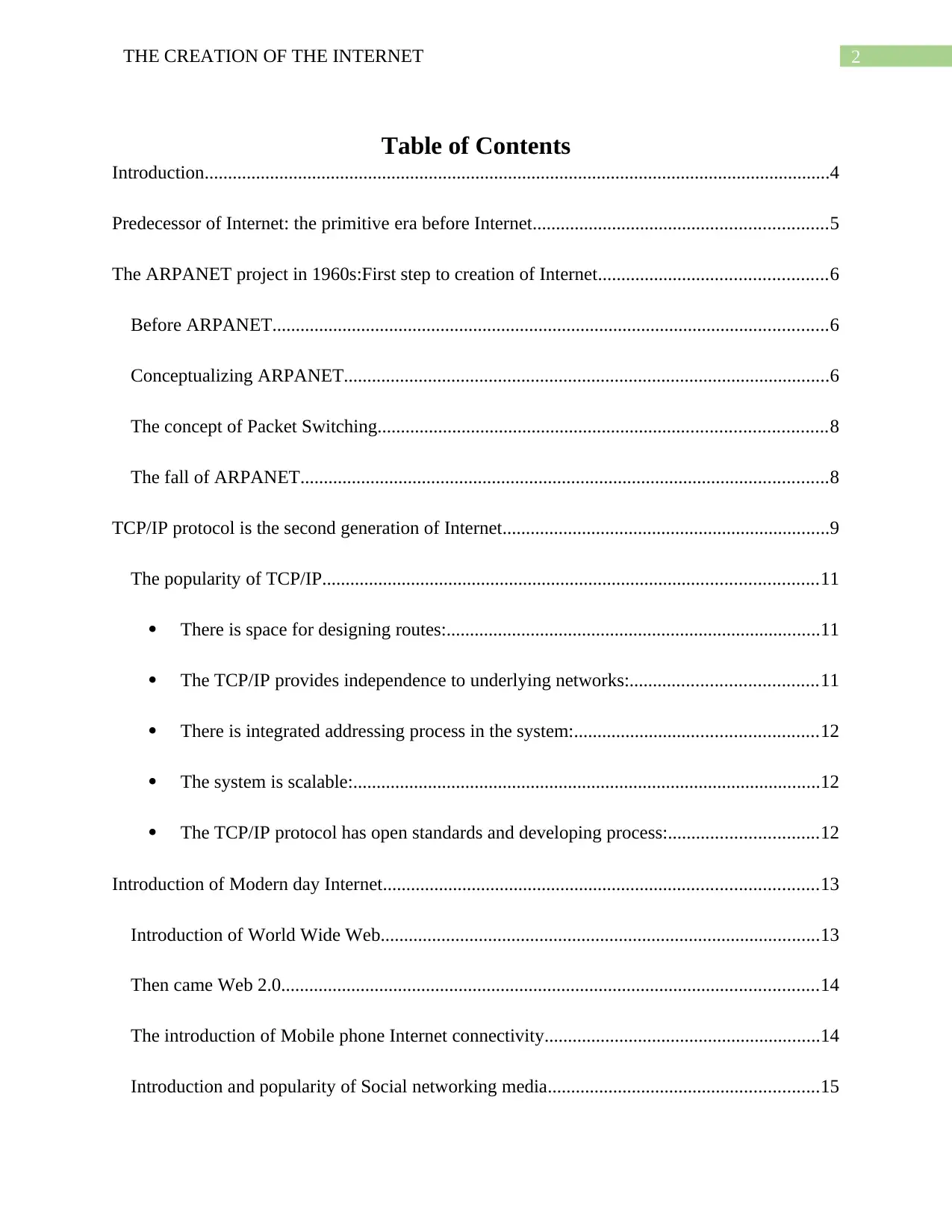
2THE CREATION OF THE INTERNET
Table of Contents
Introduction......................................................................................................................................4
Predecessor of Internet: the primitive era before Internet...............................................................5
The ARPANET project in 1960s:First step to creation of Internet.................................................6
Before ARPANET.......................................................................................................................6
Conceptualizing ARPANET........................................................................................................6
The concept of Packet Switching................................................................................................8
The fall of ARPANET.................................................................................................................8
TCP/IP protocol is the second generation of Internet......................................................................9
The popularity of TCP/IP..........................................................................................................11
There is space for designing routes:................................................................................11
The TCP/IP provides independence to underlying networks:........................................11
There is integrated addressing process in the system:....................................................12
The system is scalable:....................................................................................................12
The TCP/IP protocol has open standards and developing process:................................12
Introduction of Modern day Internet.............................................................................................13
Introduction of World Wide Web..............................................................................................13
Then came Web 2.0...................................................................................................................14
The introduction of Mobile phone Internet connectivity...........................................................14
Introduction and popularity of Social networking media..........................................................15
Table of Contents
Introduction......................................................................................................................................4
Predecessor of Internet: the primitive era before Internet...............................................................5
The ARPANET project in 1960s:First step to creation of Internet.................................................6
Before ARPANET.......................................................................................................................6
Conceptualizing ARPANET........................................................................................................6
The concept of Packet Switching................................................................................................8
The fall of ARPANET.................................................................................................................8
TCP/IP protocol is the second generation of Internet......................................................................9
The popularity of TCP/IP..........................................................................................................11
There is space for designing routes:................................................................................11
The TCP/IP provides independence to underlying networks:........................................11
There is integrated addressing process in the system:....................................................12
The system is scalable:....................................................................................................12
The TCP/IP protocol has open standards and developing process:................................12
Introduction of Modern day Internet.............................................................................................13
Introduction of World Wide Web..............................................................................................13
Then came Web 2.0...................................................................................................................14
The introduction of Mobile phone Internet connectivity...........................................................14
Introduction and popularity of Social networking media..........................................................15
⊘ This is a preview!⊘
Do you want full access?
Subscribe today to unlock all pages.

Trusted by 1+ million students worldwide

3THE CREATION OF THE INTERNET
The introduction of Internet-of-Things for better communication............................................17
Conclusion.....................................................................................................................................17
References......................................................................................................................................18
The introduction of Internet-of-Things for better communication............................................17
Conclusion.....................................................................................................................................17
References......................................................................................................................................18
Paraphrase This Document
Need a fresh take? Get an instant paraphrase of this document with our AI Paraphraser
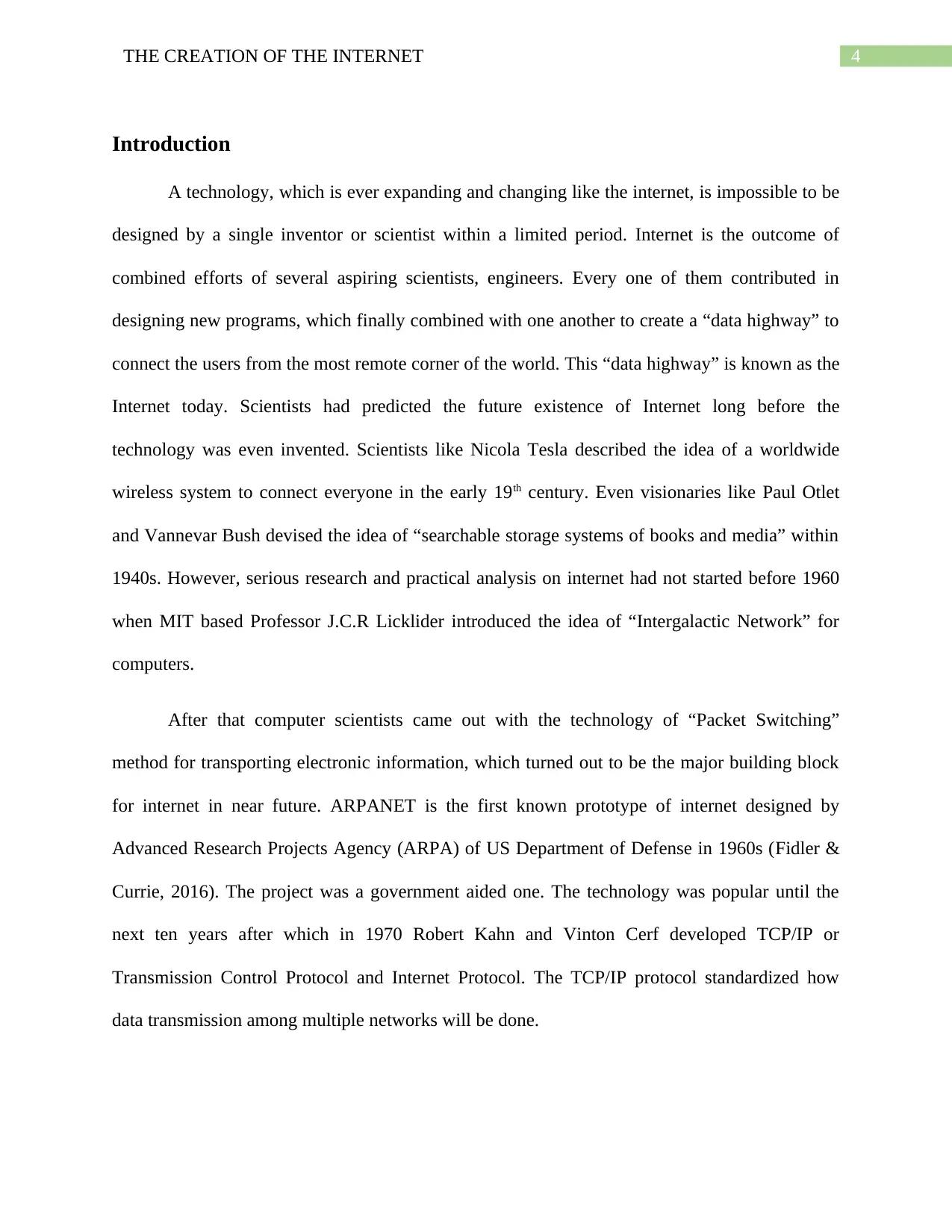
4THE CREATION OF THE INTERNET
Introduction
A technology, which is ever expanding and changing like the internet, is impossible to be
designed by a single inventor or scientist within a limited period. Internet is the outcome of
combined efforts of several aspiring scientists, engineers. Every one of them contributed in
designing new programs, which finally combined with one another to create a “data highway” to
connect the users from the most remote corner of the world. This “data highway” is known as the
Internet today. Scientists had predicted the future existence of Internet long before the
technology was even invented. Scientists like Nicola Tesla described the idea of a worldwide
wireless system to connect everyone in the early 19th century. Even visionaries like Paul Otlet
and Vannevar Bush devised the idea of “searchable storage systems of books and media” within
1940s. However, serious research and practical analysis on internet had not started before 1960
when MIT based Professor J.C.R Licklider introduced the idea of “Intergalactic Network” for
computers.
After that computer scientists came out with the technology of “Packet Switching”
method for transporting electronic information, which turned out to be the major building block
for internet in near future. ARPANET is the first known prototype of internet designed by
Advanced Research Projects Agency (ARPA) of US Department of Defense in 1960s (Fidler &
Currie, 2016). The project was a government aided one. The technology was popular until the
next ten years after which in 1970 Robert Kahn and Vinton Cerf developed TCP/IP or
Transmission Control Protocol and Internet Protocol. The TCP/IP protocol standardized how
data transmission among multiple networks will be done.
Introduction
A technology, which is ever expanding and changing like the internet, is impossible to be
designed by a single inventor or scientist within a limited period. Internet is the outcome of
combined efforts of several aspiring scientists, engineers. Every one of them contributed in
designing new programs, which finally combined with one another to create a “data highway” to
connect the users from the most remote corner of the world. This “data highway” is known as the
Internet today. Scientists had predicted the future existence of Internet long before the
technology was even invented. Scientists like Nicola Tesla described the idea of a worldwide
wireless system to connect everyone in the early 19th century. Even visionaries like Paul Otlet
and Vannevar Bush devised the idea of “searchable storage systems of books and media” within
1940s. However, serious research and practical analysis on internet had not started before 1960
when MIT based Professor J.C.R Licklider introduced the idea of “Intergalactic Network” for
computers.
After that computer scientists came out with the technology of “Packet Switching”
method for transporting electronic information, which turned out to be the major building block
for internet in near future. ARPANET is the first known prototype of internet designed by
Advanced Research Projects Agency (ARPA) of US Department of Defense in 1960s (Fidler &
Currie, 2016). The project was a government aided one. The technology was popular until the
next ten years after which in 1970 Robert Kahn and Vinton Cerf developed TCP/IP or
Transmission Control Protocol and Internet Protocol. The TCP/IP protocol standardized how
data transmission among multiple networks will be done.
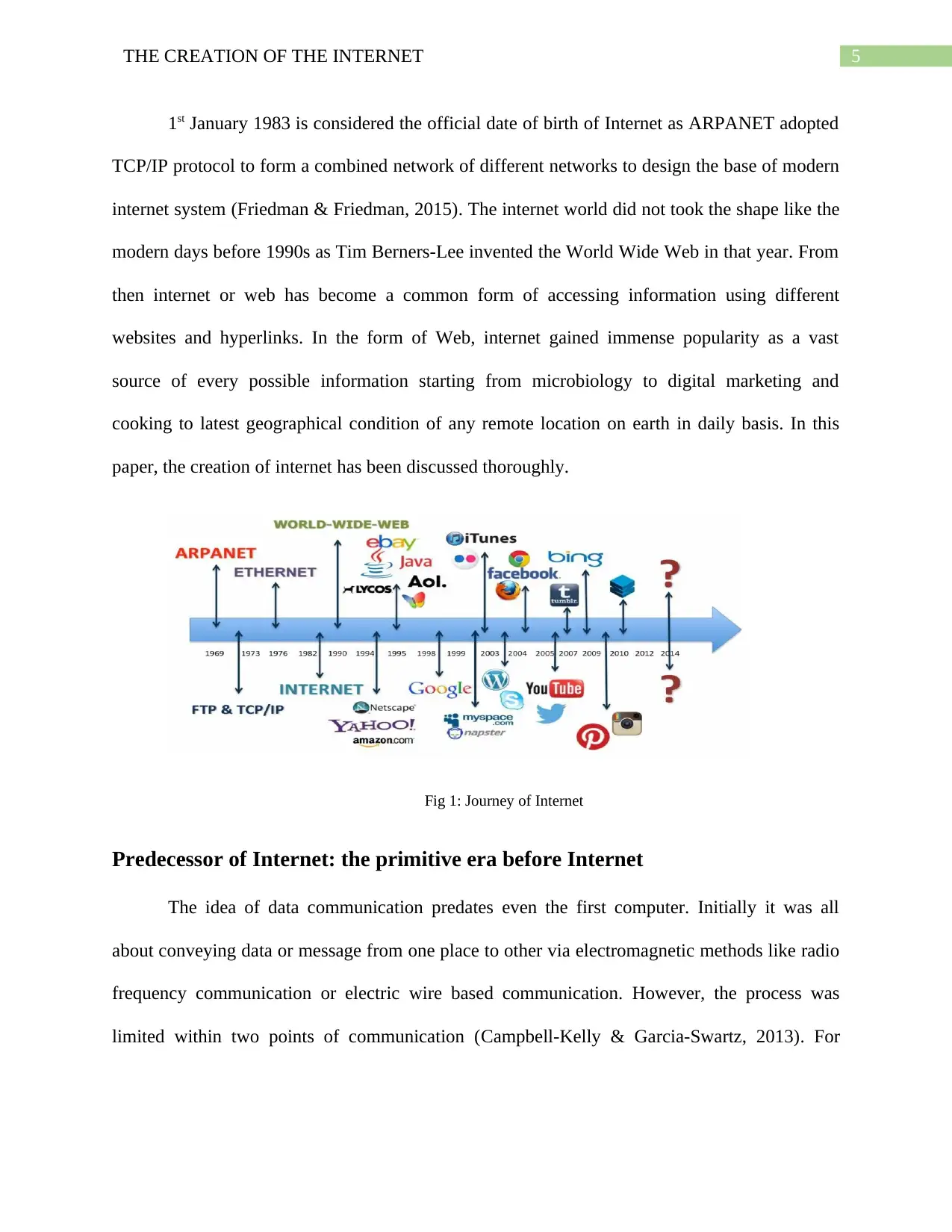
5THE CREATION OF THE INTERNET
1st January 1983 is considered the official date of birth of Internet as ARPANET adopted
TCP/IP protocol to form a combined network of different networks to design the base of modern
internet system (Friedman & Friedman, 2015). The internet world did not took the shape like the
modern days before 1990s as Tim Berners-Lee invented the World Wide Web in that year. From
then internet or web has become a common form of accessing information using different
websites and hyperlinks. In the form of Web, internet gained immense popularity as a vast
source of every possible information starting from microbiology to digital marketing and
cooking to latest geographical condition of any remote location on earth in daily basis. In this
paper, the creation of internet has been discussed thoroughly.
Fig 1: Journey of Internet
Predecessor of Internet: the primitive era before Internet
The idea of data communication predates even the first computer. Initially it was all
about conveying data or message from one place to other via electromagnetic methods like radio
frequency communication or electric wire based communication. However, the process was
limited within two points of communication (Campbell-Kelly & Garcia-Swartz, 2013). For
1st January 1983 is considered the official date of birth of Internet as ARPANET adopted
TCP/IP protocol to form a combined network of different networks to design the base of modern
internet system (Friedman & Friedman, 2015). The internet world did not took the shape like the
modern days before 1990s as Tim Berners-Lee invented the World Wide Web in that year. From
then internet or web has become a common form of accessing information using different
websites and hyperlinks. In the form of Web, internet gained immense popularity as a vast
source of every possible information starting from microbiology to digital marketing and
cooking to latest geographical condition of any remote location on earth in daily basis. In this
paper, the creation of internet has been discussed thoroughly.
Fig 1: Journey of Internet
Predecessor of Internet: the primitive era before Internet
The idea of data communication predates even the first computer. Initially it was all
about conveying data or message from one place to other via electromagnetic methods like radio
frequency communication or electric wire based communication. However, the process was
limited within two points of communication (Campbell-Kelly & Garcia-Swartz, 2013). For
⊘ This is a preview!⊘
Do you want full access?
Subscribe today to unlock all pages.

Trusted by 1+ million students worldwide
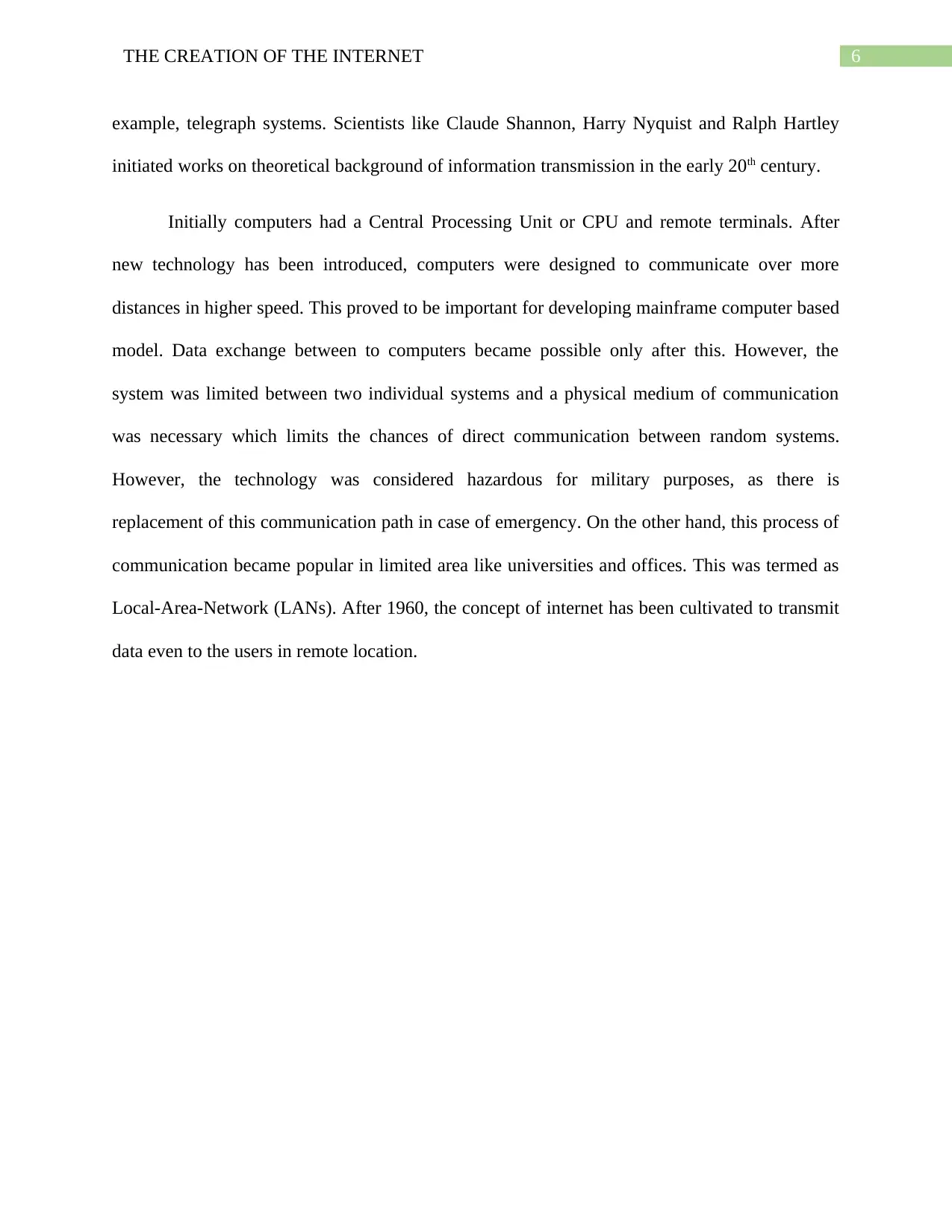
6THE CREATION OF THE INTERNET
example, telegraph systems. Scientists like Claude Shannon, Harry Nyquist and Ralph Hartley
initiated works on theoretical background of information transmission in the early 20th century.
Initially computers had a Central Processing Unit or CPU and remote terminals. After
new technology has been introduced, computers were designed to communicate over more
distances in higher speed. This proved to be important for developing mainframe computer based
model. Data exchange between to computers became possible only after this. However, the
system was limited between two individual systems and a physical medium of communication
was necessary which limits the chances of direct communication between random systems.
However, the technology was considered hazardous for military purposes, as there is
replacement of this communication path in case of emergency. On the other hand, this process of
communication became popular in limited area like universities and offices. This was termed as
Local-Area-Network (LANs). After 1960, the concept of internet has been cultivated to transmit
data even to the users in remote location.
example, telegraph systems. Scientists like Claude Shannon, Harry Nyquist and Ralph Hartley
initiated works on theoretical background of information transmission in the early 20th century.
Initially computers had a Central Processing Unit or CPU and remote terminals. After
new technology has been introduced, computers were designed to communicate over more
distances in higher speed. This proved to be important for developing mainframe computer based
model. Data exchange between to computers became possible only after this. However, the
system was limited between two individual systems and a physical medium of communication
was necessary which limits the chances of direct communication between random systems.
However, the technology was considered hazardous for military purposes, as there is
replacement of this communication path in case of emergency. On the other hand, this process of
communication became popular in limited area like universities and offices. This was termed as
Local-Area-Network (LANs). After 1960, the concept of internet has been cultivated to transmit
data even to the users in remote location.
Paraphrase This Document
Need a fresh take? Get an instant paraphrase of this document with our AI Paraphraser
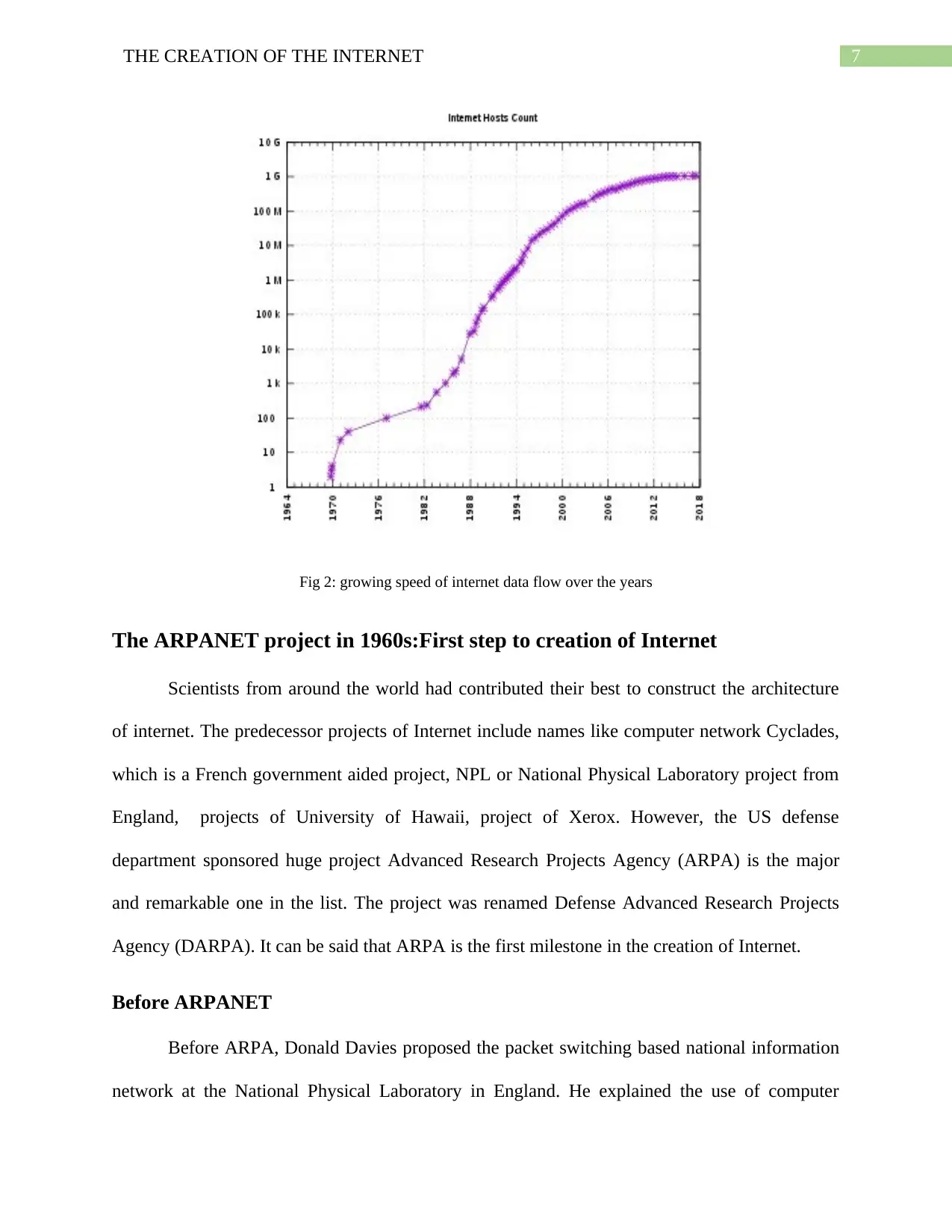
7THE CREATION OF THE INTERNET
Fig 2: growing speed of internet data flow over the years
The ARPANET project in 1960s:First step to creation of Internet
Scientists from around the world had contributed their best to construct the architecture
of internet. The predecessor projects of Internet include names like computer network Cyclades,
which is a French government aided project, NPL or National Physical Laboratory project from
England, projects of University of Hawaii, project of Xerox. However, the US defense
department sponsored huge project Advanced Research Projects Agency (ARPA) is the major
and remarkable one in the list. The project was renamed Defense Advanced Research Projects
Agency (DARPA). It can be said that ARPA is the first milestone in the creation of Internet.
Before ARPANET
Before ARPA, Donald Davies proposed the packet switching based national information
network at the National Physical Laboratory in England. He explained the use of computer
Fig 2: growing speed of internet data flow over the years
The ARPANET project in 1960s:First step to creation of Internet
Scientists from around the world had contributed their best to construct the architecture
of internet. The predecessor projects of Internet include names like computer network Cyclades,
which is a French government aided project, NPL or National Physical Laboratory project from
England, projects of University of Hawaii, project of Xerox. However, the US defense
department sponsored huge project Advanced Research Projects Agency (ARPA) is the major
and remarkable one in the list. The project was renamed Defense Advanced Research Projects
Agency (DARPA). It can be said that ARPA is the first milestone in the creation of Internet.
Before ARPANET
Before ARPA, Donald Davies proposed the packet switching based national information
network at the National Physical Laboratory in England. He explained the use of computer
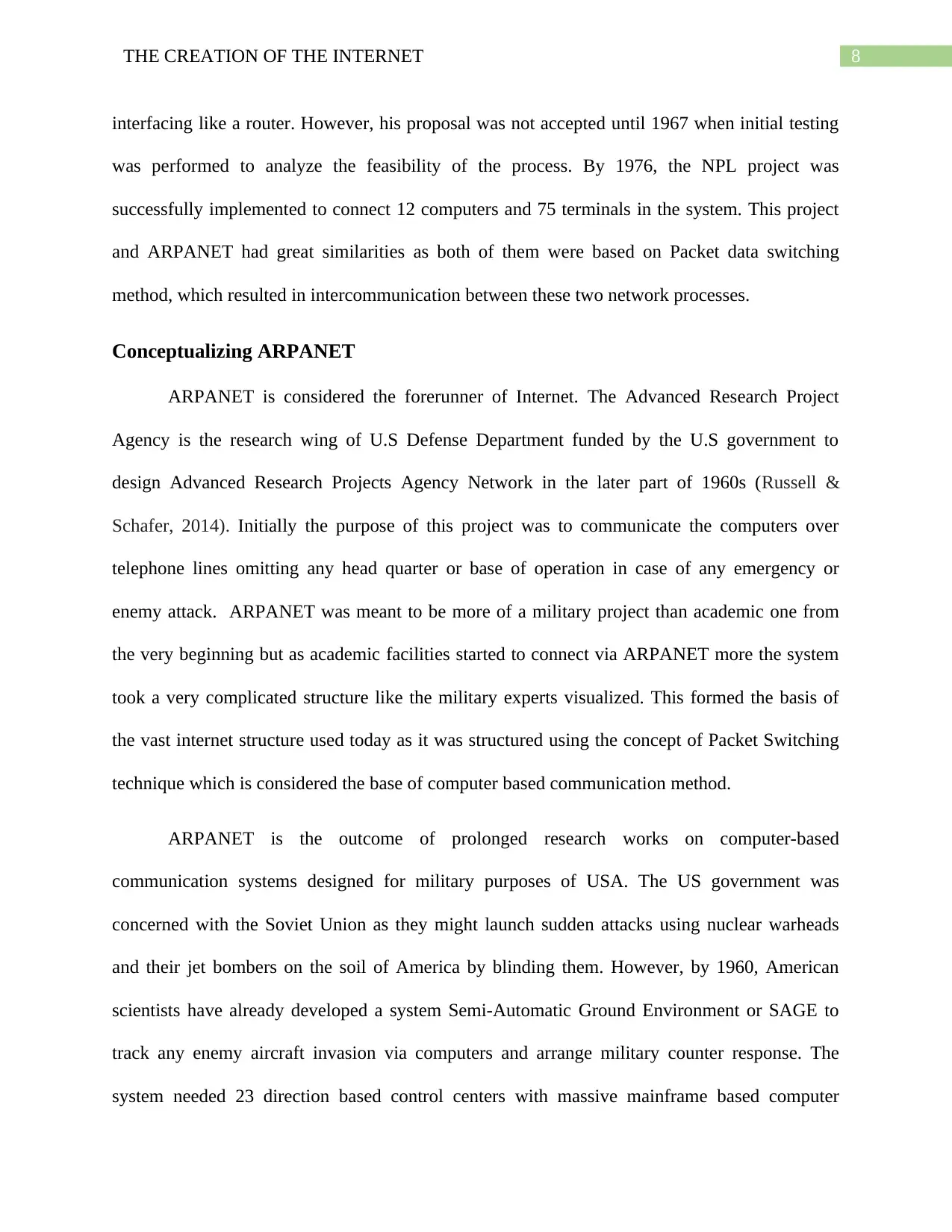
8THE CREATION OF THE INTERNET
interfacing like a router. However, his proposal was not accepted until 1967 when initial testing
was performed to analyze the feasibility of the process. By 1976, the NPL project was
successfully implemented to connect 12 computers and 75 terminals in the system. This project
and ARPANET had great similarities as both of them were based on Packet data switching
method, which resulted in intercommunication between these two network processes.
Conceptualizing ARPANET
ARPANET is considered the forerunner of Internet. The Advanced Research Project
Agency is the research wing of U.S Defense Department funded by the U.S government to
design Advanced Research Projects Agency Network in the later part of 1960s (Russell &
Schafer, 2014). Initially the purpose of this project was to communicate the computers over
telephone lines omitting any head quarter or base of operation in case of any emergency or
enemy attack. ARPANET was meant to be more of a military project than academic one from
the very beginning but as academic facilities started to connect via ARPANET more the system
took a very complicated structure like the military experts visualized. This formed the basis of
the vast internet structure used today as it was structured using the concept of Packet Switching
technique which is considered the base of computer based communication method.
ARPANET is the outcome of prolonged research works on computer-based
communication systems designed for military purposes of USA. The US government was
concerned with the Soviet Union as they might launch sudden attacks using nuclear warheads
and their jet bombers on the soil of America by blinding them. However, by 1960, American
scientists have already developed a system Semi-Automatic Ground Environment or SAGE to
track any enemy aircraft invasion via computers and arrange military counter response. The
system needed 23 direction based control centers with massive mainframe based computer
interfacing like a router. However, his proposal was not accepted until 1967 when initial testing
was performed to analyze the feasibility of the process. By 1976, the NPL project was
successfully implemented to connect 12 computers and 75 terminals in the system. This project
and ARPANET had great similarities as both of them were based on Packet data switching
method, which resulted in intercommunication between these two network processes.
Conceptualizing ARPANET
ARPANET is considered the forerunner of Internet. The Advanced Research Project
Agency is the research wing of U.S Defense Department funded by the U.S government to
design Advanced Research Projects Agency Network in the later part of 1960s (Russell &
Schafer, 2014). Initially the purpose of this project was to communicate the computers over
telephone lines omitting any head quarter or base of operation in case of any emergency or
enemy attack. ARPANET was meant to be more of a military project than academic one from
the very beginning but as academic facilities started to connect via ARPANET more the system
took a very complicated structure like the military experts visualized. This formed the basis of
the vast internet structure used today as it was structured using the concept of Packet Switching
technique which is considered the base of computer based communication method.
ARPANET is the outcome of prolonged research works on computer-based
communication systems designed for military purposes of USA. The US government was
concerned with the Soviet Union as they might launch sudden attacks using nuclear warheads
and their jet bombers on the soil of America by blinding them. However, by 1960, American
scientists have already developed a system Semi-Automatic Ground Environment or SAGE to
track any enemy aircraft invasion via computers and arrange military counter response. The
system needed 23 direction based control centers with massive mainframe based computer
⊘ This is a preview!⊘
Do you want full access?
Subscribe today to unlock all pages.

Trusted by 1+ million students worldwide
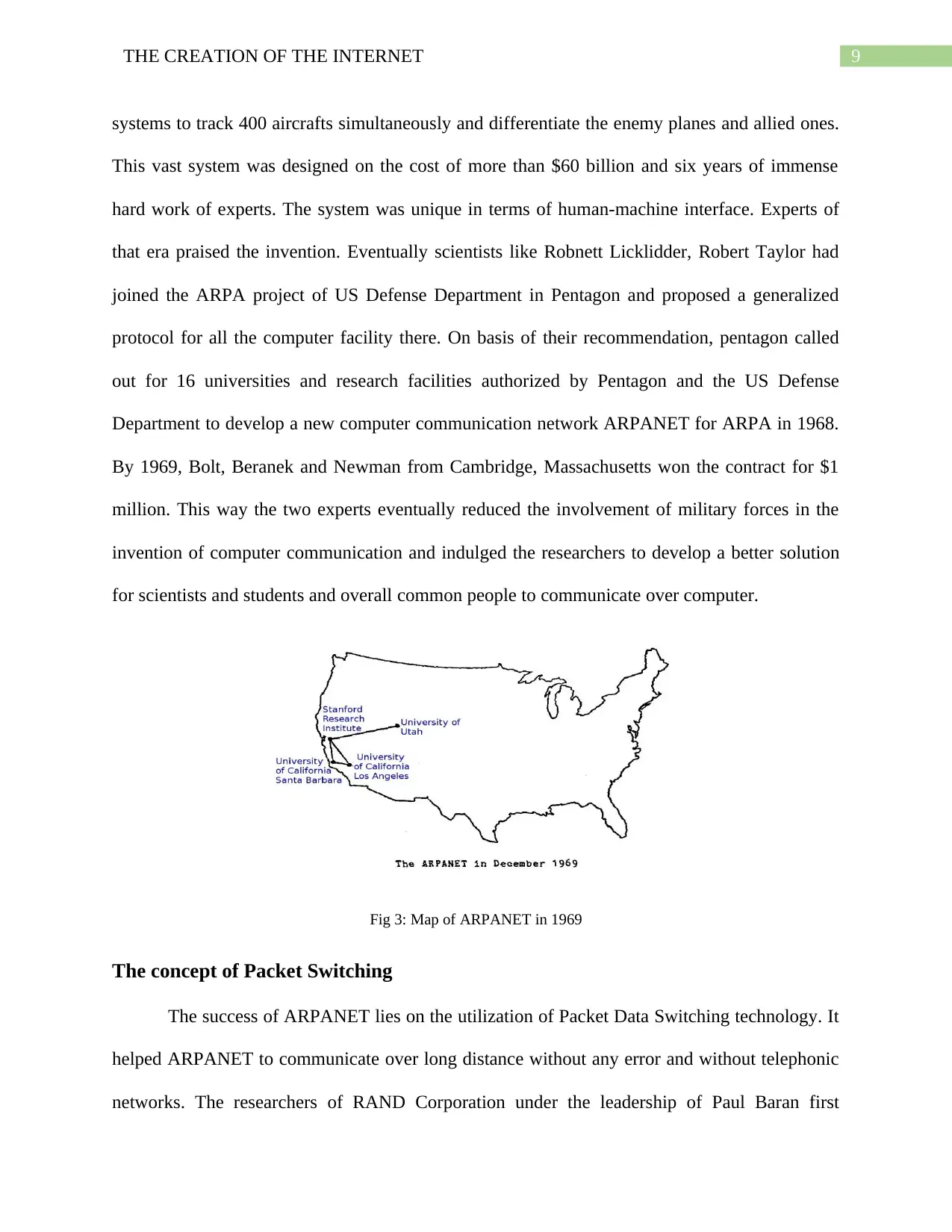
9THE CREATION OF THE INTERNET
systems to track 400 aircrafts simultaneously and differentiate the enemy planes and allied ones.
This vast system was designed on the cost of more than $60 billion and six years of immense
hard work of experts. The system was unique in terms of human-machine interface. Experts of
that era praised the invention. Eventually scientists like Robnett Licklidder, Robert Taylor had
joined the ARPA project of US Defense Department in Pentagon and proposed a generalized
protocol for all the computer facility there. On basis of their recommendation, pentagon called
out for 16 universities and research facilities authorized by Pentagon and the US Defense
Department to develop a new computer communication network ARPANET for ARPA in 1968.
By 1969, Bolt, Beranek and Newman from Cambridge, Massachusetts won the contract for $1
million. This way the two experts eventually reduced the involvement of military forces in the
invention of computer communication and indulged the researchers to develop a better solution
for scientists and students and overall common people to communicate over computer.
Fig 3: Map of ARPANET in 1969
The concept of Packet Switching
The success of ARPANET lies on the utilization of Packet Data Switching technology. It
helped ARPANET to communicate over long distance without any error and without telephonic
networks. The researchers of RAND Corporation under the leadership of Paul Baran first
systems to track 400 aircrafts simultaneously and differentiate the enemy planes and allied ones.
This vast system was designed on the cost of more than $60 billion and six years of immense
hard work of experts. The system was unique in terms of human-machine interface. Experts of
that era praised the invention. Eventually scientists like Robnett Licklidder, Robert Taylor had
joined the ARPA project of US Defense Department in Pentagon and proposed a generalized
protocol for all the computer facility there. On basis of their recommendation, pentagon called
out for 16 universities and research facilities authorized by Pentagon and the US Defense
Department to develop a new computer communication network ARPANET for ARPA in 1968.
By 1969, Bolt, Beranek and Newman from Cambridge, Massachusetts won the contract for $1
million. This way the two experts eventually reduced the involvement of military forces in the
invention of computer communication and indulged the researchers to develop a better solution
for scientists and students and overall common people to communicate over computer.
Fig 3: Map of ARPANET in 1969
The concept of Packet Switching
The success of ARPANET lies on the utilization of Packet Data Switching technology. It
helped ARPANET to communicate over long distance without any error and without telephonic
networks. The researchers of RAND Corporation under the leadership of Paul Baran first
Paraphrase This Document
Need a fresh take? Get an instant paraphrase of this document with our AI Paraphraser
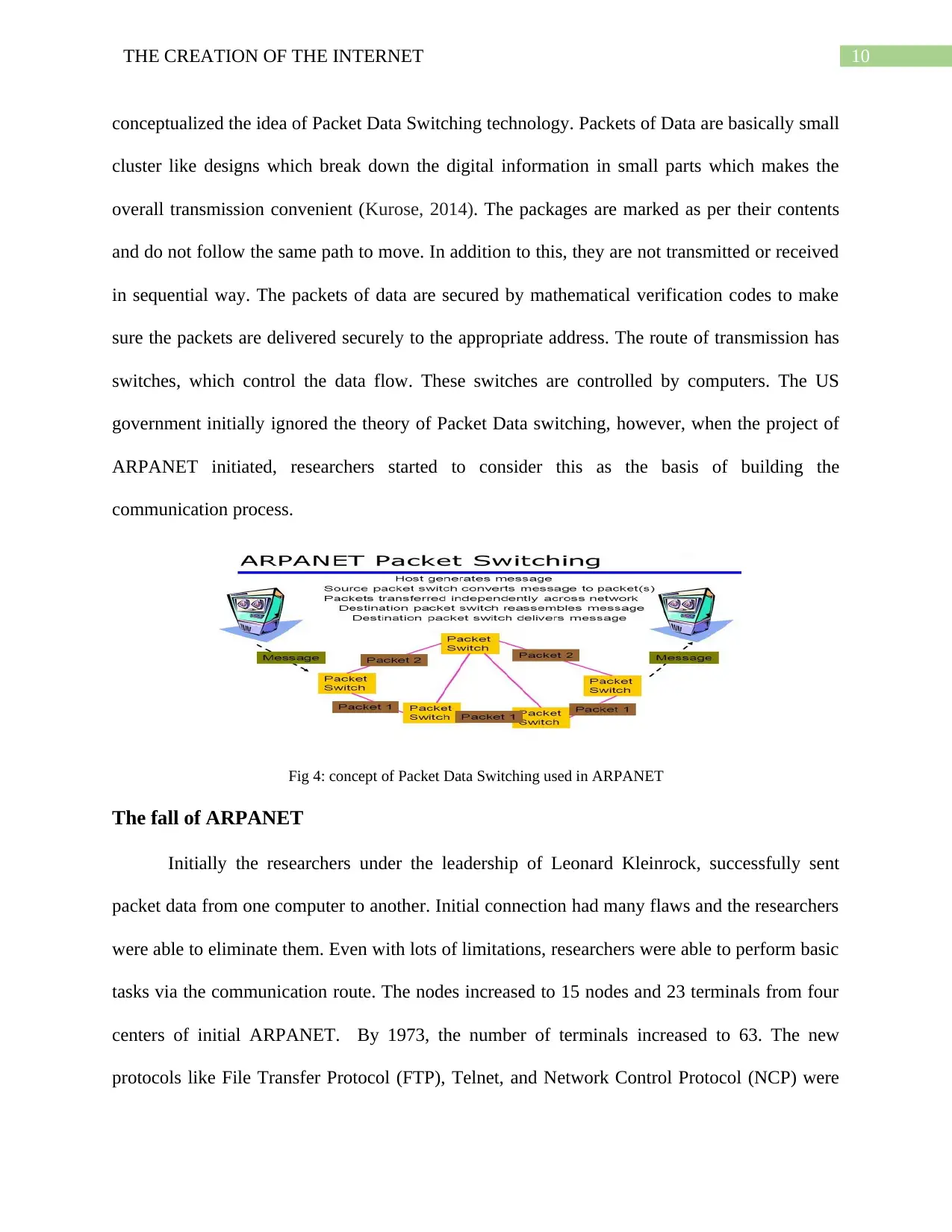
10THE CREATION OF THE INTERNET
conceptualized the idea of Packet Data Switching technology. Packets of Data are basically small
cluster like designs which break down the digital information in small parts which makes the
overall transmission convenient (Kurose, 2014). The packages are marked as per their contents
and do not follow the same path to move. In addition to this, they are not transmitted or received
in sequential way. The packets of data are secured by mathematical verification codes to make
sure the packets are delivered securely to the appropriate address. The route of transmission has
switches, which control the data flow. These switches are controlled by computers. The US
government initially ignored the theory of Packet Data switching, however, when the project of
ARPANET initiated, researchers started to consider this as the basis of building the
communication process.
Fig 4: concept of Packet Data Switching used in ARPANET
The fall of ARPANET
Initially the researchers under the leadership of Leonard Kleinrock, successfully sent
packet data from one computer to another. Initial connection had many flaws and the researchers
were able to eliminate them. Even with lots of limitations, researchers were able to perform basic
tasks via the communication route. The nodes increased to 15 nodes and 23 terminals from four
centers of initial ARPANET. By 1973, the number of terminals increased to 63. The new
protocols like File Transfer Protocol (FTP), Telnet, and Network Control Protocol (NCP) were
conceptualized the idea of Packet Data Switching technology. Packets of Data are basically small
cluster like designs which break down the digital information in small parts which makes the
overall transmission convenient (Kurose, 2014). The packages are marked as per their contents
and do not follow the same path to move. In addition to this, they are not transmitted or received
in sequential way. The packets of data are secured by mathematical verification codes to make
sure the packets are delivered securely to the appropriate address. The route of transmission has
switches, which control the data flow. These switches are controlled by computers. The US
government initially ignored the theory of Packet Data switching, however, when the project of
ARPANET initiated, researchers started to consider this as the basis of building the
communication process.
Fig 4: concept of Packet Data Switching used in ARPANET
The fall of ARPANET
Initially the researchers under the leadership of Leonard Kleinrock, successfully sent
packet data from one computer to another. Initial connection had many flaws and the researchers
were able to eliminate them. Even with lots of limitations, researchers were able to perform basic
tasks via the communication route. The nodes increased to 15 nodes and 23 terminals from four
centers of initial ARPANET. By 1973, the number of terminals increased to 63. The new
protocols like File Transfer Protocol (FTP), Telnet, and Network Control Protocol (NCP) were
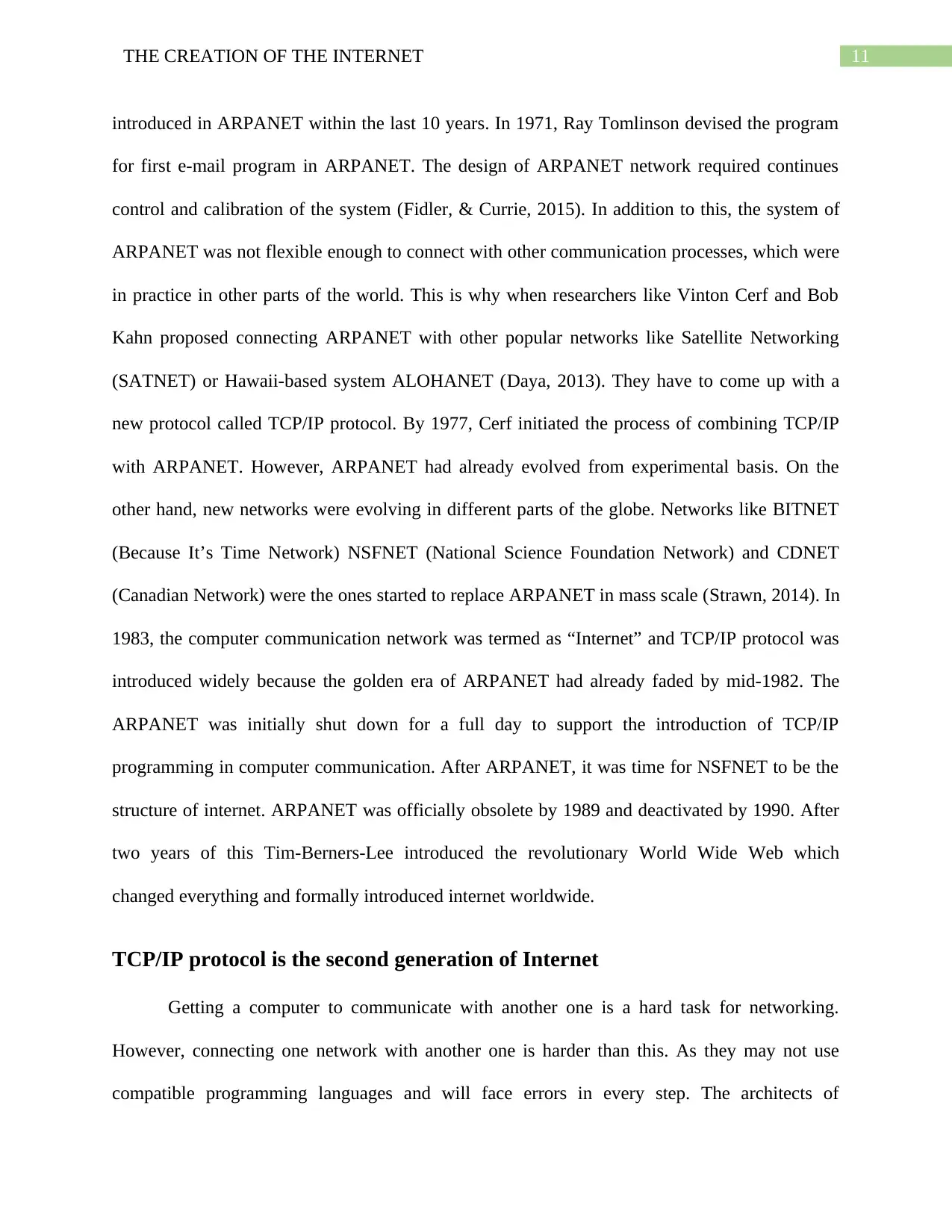
11THE CREATION OF THE INTERNET
introduced in ARPANET within the last 10 years. In 1971, Ray Tomlinson devised the program
for first e-mail program in ARPANET. The design of ARPANET network required continues
control and calibration of the system (Fidler, & Currie, 2015). In addition to this, the system of
ARPANET was not flexible enough to connect with other communication processes, which were
in practice in other parts of the world. This is why when researchers like Vinton Cerf and Bob
Kahn proposed connecting ARPANET with other popular networks like Satellite Networking
(SATNET) or Hawaii-based system ALOHANET (Daya, 2013). They have to come up with a
new protocol called TCP/IP protocol. By 1977, Cerf initiated the process of combining TCP/IP
with ARPANET. However, ARPANET had already evolved from experimental basis. On the
other hand, new networks were evolving in different parts of the globe. Networks like BITNET
(Because It’s Time Network) NSFNET (National Science Foundation Network) and CDNET
(Canadian Network) were the ones started to replace ARPANET in mass scale (Strawn, 2014). In
1983, the computer communication network was termed as “Internet” and TCP/IP protocol was
introduced widely because the golden era of ARPANET had already faded by mid-1982. The
ARPANET was initially shut down for a full day to support the introduction of TCP/IP
programming in computer communication. After ARPANET, it was time for NSFNET to be the
structure of internet. ARPANET was officially obsolete by 1989 and deactivated by 1990. After
two years of this Tim-Berners-Lee introduced the revolutionary World Wide Web which
changed everything and formally introduced internet worldwide.
TCP/IP protocol is the second generation of Internet
Getting a computer to communicate with another one is a hard task for networking.
However, connecting one network with another one is harder than this. As they may not use
compatible programming languages and will face errors in every step. The architects of
introduced in ARPANET within the last 10 years. In 1971, Ray Tomlinson devised the program
for first e-mail program in ARPANET. The design of ARPANET network required continues
control and calibration of the system (Fidler, & Currie, 2015). In addition to this, the system of
ARPANET was not flexible enough to connect with other communication processes, which were
in practice in other parts of the world. This is why when researchers like Vinton Cerf and Bob
Kahn proposed connecting ARPANET with other popular networks like Satellite Networking
(SATNET) or Hawaii-based system ALOHANET (Daya, 2013). They have to come up with a
new protocol called TCP/IP protocol. By 1977, Cerf initiated the process of combining TCP/IP
with ARPANET. However, ARPANET had already evolved from experimental basis. On the
other hand, new networks were evolving in different parts of the globe. Networks like BITNET
(Because It’s Time Network) NSFNET (National Science Foundation Network) and CDNET
(Canadian Network) were the ones started to replace ARPANET in mass scale (Strawn, 2014). In
1983, the computer communication network was termed as “Internet” and TCP/IP protocol was
introduced widely because the golden era of ARPANET had already faded by mid-1982. The
ARPANET was initially shut down for a full day to support the introduction of TCP/IP
programming in computer communication. After ARPANET, it was time for NSFNET to be the
structure of internet. ARPANET was officially obsolete by 1989 and deactivated by 1990. After
two years of this Tim-Berners-Lee introduced the revolutionary World Wide Web which
changed everything and formally introduced internet worldwide.
TCP/IP protocol is the second generation of Internet
Getting a computer to communicate with another one is a hard task for networking.
However, connecting one network with another one is harder than this. As they may not use
compatible programming languages and will face errors in every step. The architects of
⊘ This is a preview!⊘
Do you want full access?
Subscribe today to unlock all pages.

Trusted by 1+ million students worldwide
1 out of 26
Related Documents
Your All-in-One AI-Powered Toolkit for Academic Success.
+13062052269
info@desklib.com
Available 24*7 on WhatsApp / Email
![[object Object]](/_next/static/media/star-bottom.7253800d.svg)
Unlock your academic potential
Copyright © 2020–2025 A2Z Services. All Rights Reserved. Developed and managed by ZUCOL.



